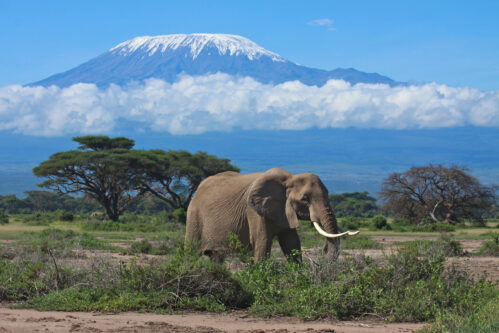
Mount Kilimanjaro, Africa’s highest mountain, stands tall at 5,895 meters (19,341 feet) above sea level. Located in Tanzania, near the border with Kenya, it is one of the world’s most accessible high summits, attracting thousands of climbers each year. The mountain’s unique weather conditions, shaped by its geographical location and elevation, are an essential aspect that climbers must consider when planning their Kilimanjaro adventure. In this blog post, we will delve into the different weather conditions found on the mountain and provide insights on the best time to climb.
Kilimanjaro’s Climate Zones
Mount Kilimanjaro’s weather conditions can be categorized into five distinct climate zones:
1. Cultivation Zone (800 – 1,800 meters): The lower slopes of the mountain are characterized by warm temperatures, heavy rainfall, and lush vegetation. The average temperature in this zone ranges between 21 – 27°C (70 – 80°F).
2. Rainforest Zone (1,800 – 2,800 meters): As you ascend the mountain, you enter the rainforest zone, where the temperature is cooler and humidity is high. Expect rainfall throughout the year, with temperatures ranging from 12 – 20°C (54 – 68°F).
3. Heather-Moorland Zone (2,800 – 4,000 meters): The vegetation changes to heather and moorland as you climb higher. Temperatures drop further, ranging from 5 – 15°C (41 – 59°F), and rainfall decreases.
4. Alpine Desert Zone (4,000 – 5,000 meters): In this zone, the landscape becomes barren, with little vegetation. Daytime temperatures can range from 10 – 20°C (50 – 68°F), but they can drop dramatically at night, reaching below freezing.
5. Arctic Zone (5,000 meters and above): Finally, the summit of Kilimanjaro is characterized by freezing temperatures, strong winds, and a snow and ice-covered landscape. Temperatures can drop as low as -20°C (-4°F).
Understanding Kilimanjaro’s Seasons
Kilimanjaro’s weather can be divided into two main seasons: the dry season and the wet season. The dry season is generally considered the best time to climb the mountain, as the paths are less muddy and slippery, and there is a lower risk of encountering heavy rainfall.
1. Dry Season: The long dry season occurs from June to October, while the short dry season takes place from January to February. During these months, the weather is relatively stable, with clear skies and little precipitation. However, temperatures can still fluctuate significantly, especially at higher altitudes.
2. Wet Season: The wet season is divided into the long rainy season from March to May and the short rainy season in November and December. Climbing during these months can be more challenging due to muddy trails, reduced visibility, and increased risk of altitude sickness due to the colder and wetter conditions.
Best Time to Climb Kilimanjaro
The best time to climb Kilimanjaro is during the dry season, particularly June to October and January to February. These months offer the most favorable weather conditions, with a lower likelihood of encountering heavy rainfall or snow. However, it’s essential to keep in mind that the weather on the mountain can be unpredictable.